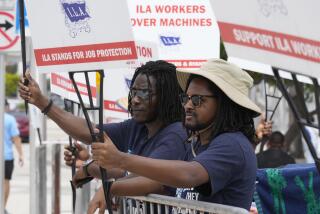New Longshore Recruits Try to Learn the Ropes
- Share via
The tools of Adrienne Lopez’s new trade are a mix of steel poles, turnbuckles and metal locking cones that looks as difficult to master as a set of Rubik’s cubes.
Under the watchful eye this week of a veteran longshoreman instructor, Lopez lifted two 53-pound metal bars and secured them to both ends of a shipping container in a parking lot that served as a makeshift maritime academy. Lopez was preparing for some of the most dangerous work at the ports of Long Beach and Los Angeles -- tying down cargo containers that can weigh 60,000 pounds.
“Adrienne,” said instructor Rene Lemon, pausing for effect before breaking into a broad grin. “You are my star pupil.”
Lopez and her two dozen classmates were among the lucky lottery winners pulled from more than 300,000 applicants for 3,000 nonunion jobs at the nation’s busiest seaports. The jobs will pay $21 to $28 an hour.
As one of the first wave of recruits, Lopez, 26, underwent a five-day crash course with the International Longshore and Warehouse Union and the trade group that represents the West Coast shipping lines.
“It was harder than I thought it would be,” said Lopez, a Downey resident with muscular arms. She dressed in the usual longshore attire: a long-sleeved shirt, heavy pants and steel-toed work boots. “I was very nervous.”
Lopez is studying special education at Cerritos College and hopes to juggle classes and a longshoreman’s job. Her long-term goal is to trade one classroom for another. “I want to teach autistic children,” she said. “That’s my real dream.”
As nonunion casuals, as they’re known, Lopez and her colleagues will have to show up at the hiring hall each day to see if there’s any work. That hasn’t been a problem recently, as the ports have run out of trained longshoremen.
The controversial job lottery was the result of weeks of negotiations between the ILWU, which represents more than 11,000 dockworkers, and the shipping lines.
The first 3,000 who pass their physical examinations and drug and alcohol tests and then master basic longshore skills will help ease the labor shortage as the ports gear up for the busy holiday retail season.
If the first week of training and testing was a standard, the union and shipping lines will have to go deeper into the applicant pool to fill those 3,000 jobs.
Marc Harden, 31, a petty officer 2nd class based at the Brunswick Naval Air Station in Maine, made it through the port job lottery only to find out that he would be deployed overseas before he could end his service with the Navy. So he never made it to longshoreman school.
And Adrian White, 31, an after-school activities coordinator for the Los Angeles Unified School District, was a washout the first day because he didn’t meet one of the basic requirements for the jobs: having a valid driver’s license.
“There have been a few no-shows, but about 28 to 30 of every set of 50 lottery winners are getting through the training and are ready to go,” said Tom Rowlands, a training supervisor for the Pacific Maritime Assn.
As of Thursday, more than 220 recruits -- including Lopez -- had finished the basic training.
Another graduate was Cory Guzman, 21, who has seven family members working on the local docks. A senior at UC San Diego, Guzman wants to work as a longshoreman while finishing his business degree.
Guzman’s mother wants him to concentrate on finishing college. His dockworker dad worries there won’t be as much work in the future for his son as there is now.
But the younger Guzman has been struggling to make ends meet, working in restaurants. And he’s done the math.
“I can do this job one day a week,” he said, “and earn just as much money.”
More to Read
Sign up for Essential California
The most important California stories and recommendations in your inbox every morning.
You may occasionally receive promotional content from the Los Angeles Times.










